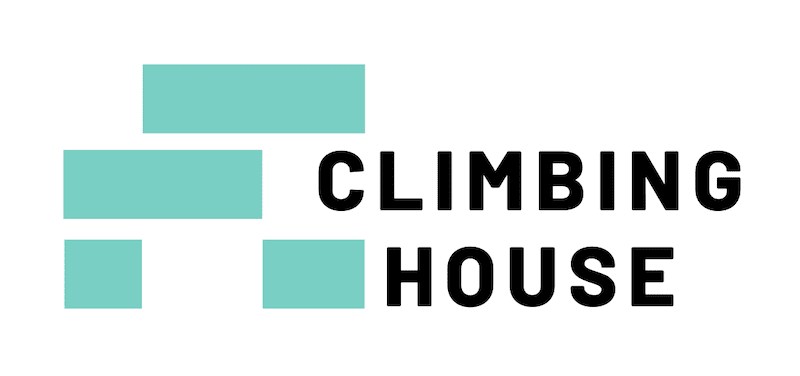The 7 Best Indoor Rock Climbing Shoes (2023 Buying Guide)
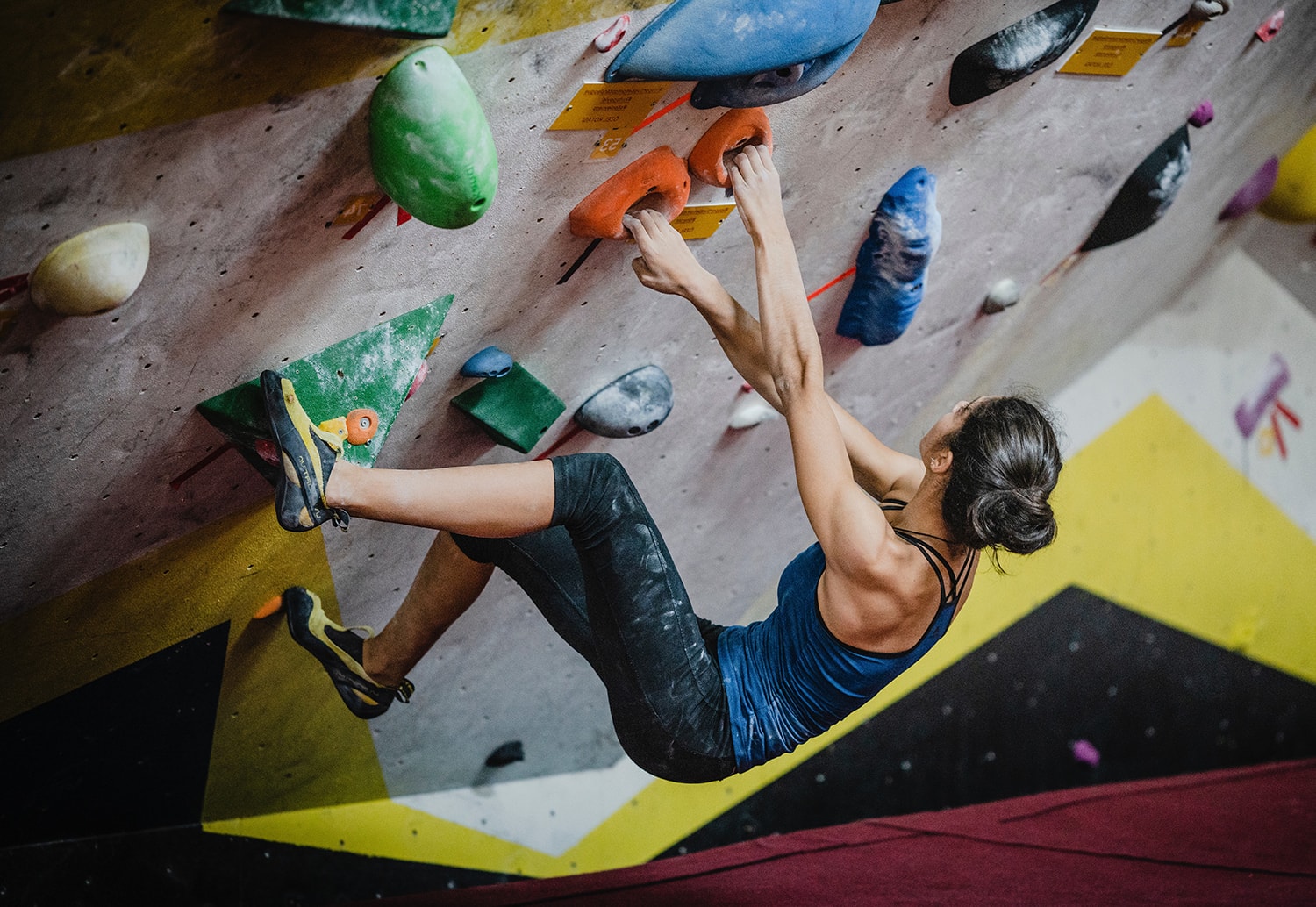
Published on: 06/01/2023
Introduction
Indoor gym climbing on artificial walls is more popular than ever these days. With the explosion of indoor facilities, and the increase in exposure from Olympic climbing events, the sport is evolving at a rapid pace.
Thanks to this popularity, more people than ever are looking for high-performing shoes for bouldering and sport climbing indoors. In this roundup, we’ve highlighted 7 great options for gym climbers depending on who you are and what you like to climb.
Let’s get started and find the best climbing shoes for your next gym workout!
Our Method

To come up with our list of the best gym climbing shoes on the market, we surveyed the Climbing House staff and fellow gym climbers to narrow down the top choices. For shoe models that we weren’t able to test in person, we analyzed original reviews from both individual users and climbing journalists to make our decisions.
Performance and fit characteristics for each shoe were collected by personal experience, in-person interviews, and a survey of online feedback from real shoe users.
Our Selection of the Best Indoor Climbing Shoes of 2023
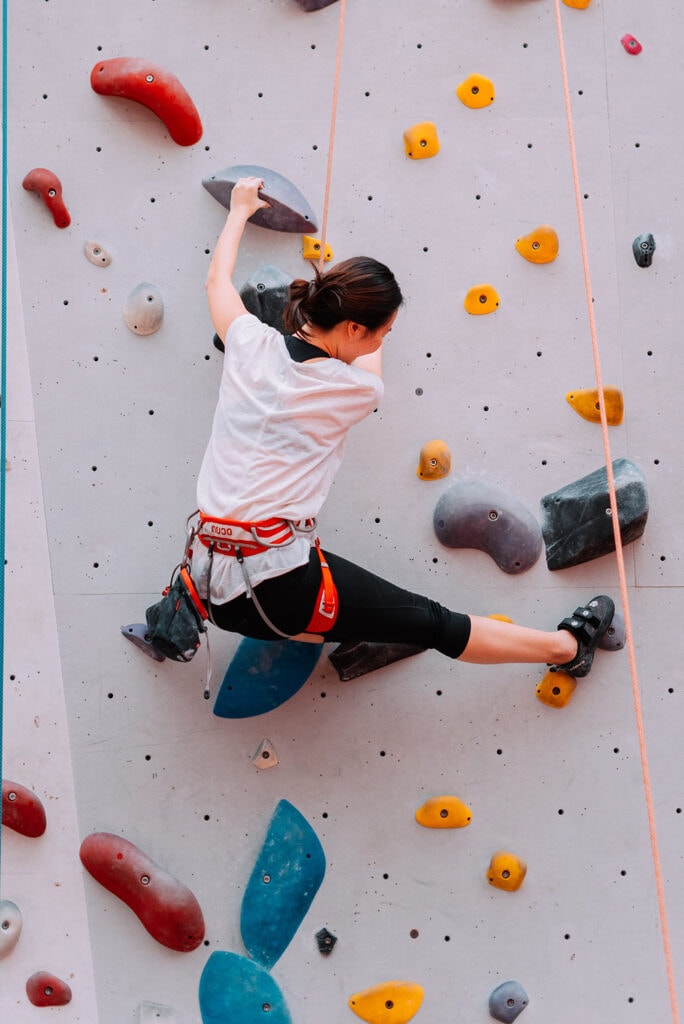
Comparison Table
| Shoe Model | Weight | Type | Vegan | Best for | Best Offer |
|---|---|---|---|---|---|
Scarpa Veloce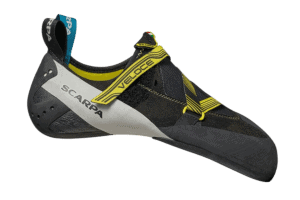 | 6.9 oz/195 g | Performance | ✔ | Beginners | Check prices |
La Sportiva Tarantula Boulder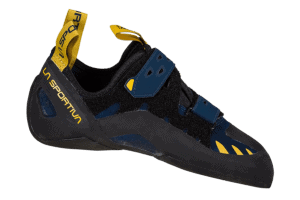 | 8.1 oz/230 g | Comfort | ❌ | Budget | Check prices |
Tenaya Tarifa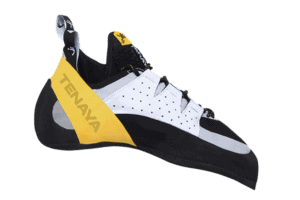 | 5.9 oz/170 g | Performance | ✔ | Sport Climbing | Check prices |
La Sportiva Solution Comp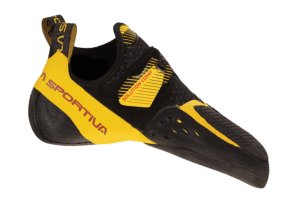 | 8.9 oz/258 g | Performance | ❌ | Women | Check prices |
La Sportiva Skwama Women’s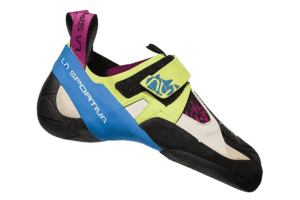 | 7.4 oz/210 g | Performance | ❌ | Bouldering | Check prices |
Evolv Venga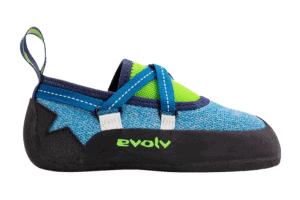 | n/a | Comfort | ✔ | Kids | Check prices |
Scarpa Drago LV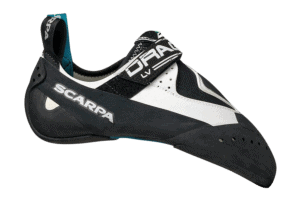 | 1 oz/200 g | Performance | ❌ | Competition Climbing | Check prices |
1. Scarpa Veloce: Best Gym Climbing Shoe for Beginners
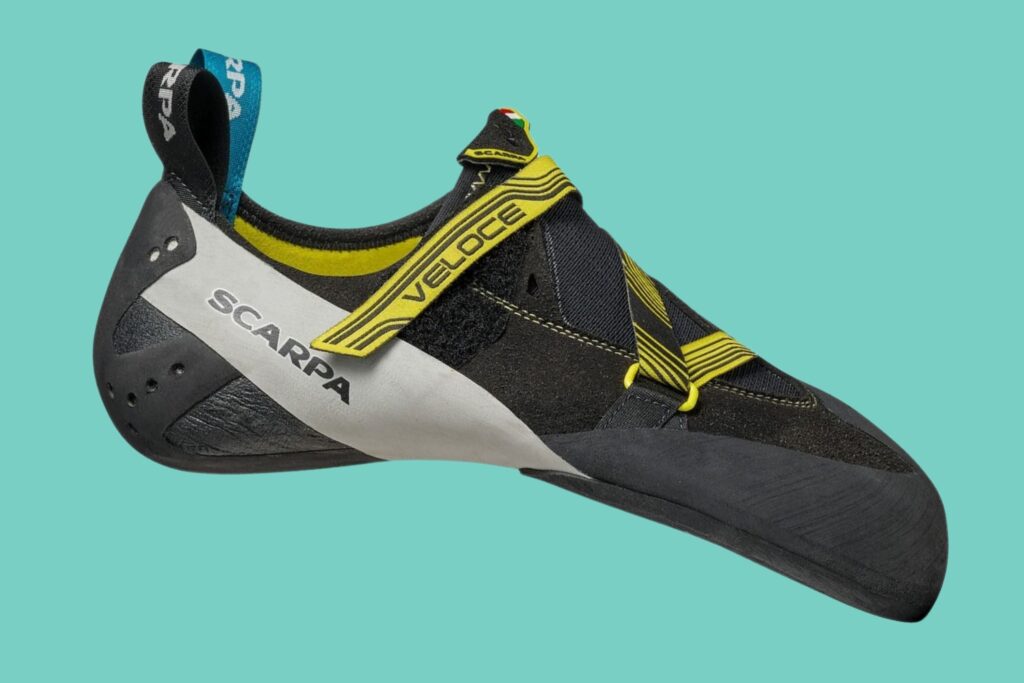
Important Specs
Weight: 6.9 oz/195 g (size 40.5)
Upper: Microsuede
Outsole: S-72 4 mm
Midsole: 1.0 mm Flexan
Vegan: Yes
Resoleable: Yes
The Veloce was designed from the ground up for gym climbing and long sessions. The best feature of this shoe may be the last, with extra volume in the forefoot area to eliminate the painful toe squashing that most shoes force on us.
At the same time, Scarpa added a slight downturn and mild asymmetry to boost performance above the average beginner shoe. The wide toe box is not good for narrow cracks or pockets, but those types of features aren’t common indoors. A moderately stiff midsole provides support without sacrificing sensitivity.
The Veloce has a price to match its wealth of technical features, but it’s still a great value for beginners who want a shoe that will grow along with their abilities. And, some experienced climbers downsize 2 or more sizes from street shoe size to achieve more capability while still avoiding toe pain.
Pros
Cons
2. La Sportiva Tarantula Boulder: Best Budget Gym Climbing Shoes
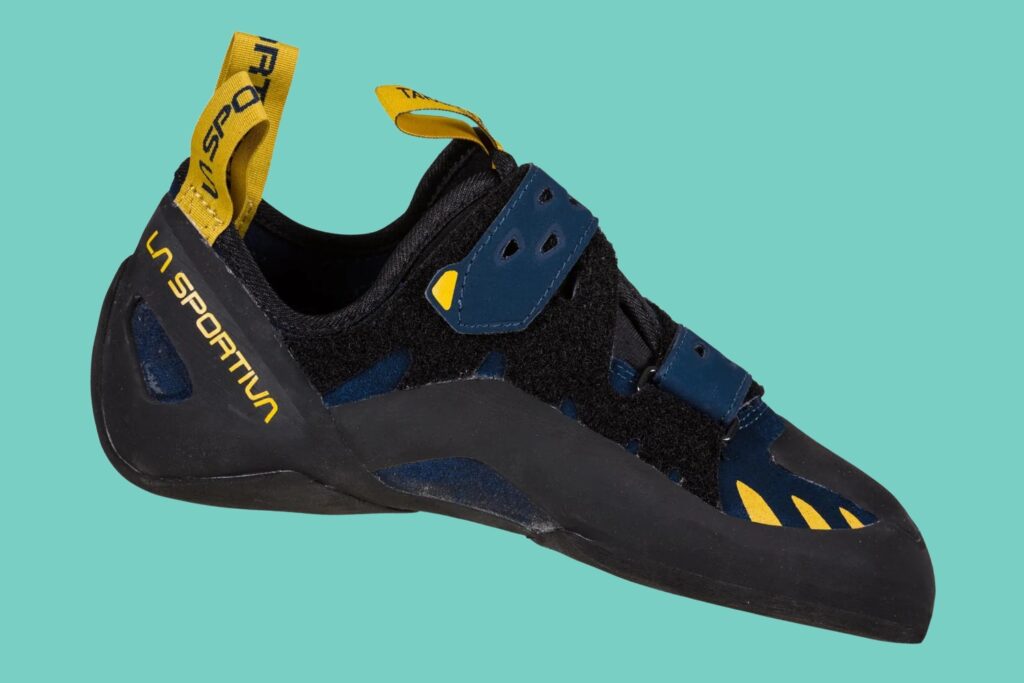
Important Specs
Weight: 8.1 oz/230 g
Upper: Leather
Outsole: 5 mm/0.2 in FriXion RS
Midsole: 1.1 mm/0.04 in Laspoflex
Vegan: No
Resoleable: Yes
The La Sportiva Tarantula Boulder is a recently released model based on the bestselling Tarantula and Tarantulace, long-time favorites of beginners due to their lower price point and adaptable fit. One major downside of the original models are their limitations on small holds due to a lack of feel and flat last.
While the Tarantula Boulder is built on the same last as its siblings, a few key changes have improved both sensitivity and its capabilities for techy footwork. First, the midsole is reduced from 1.8 mm (0.07 in) to 1.1 mm (0.04 in) to help your feel on tiny jibs and edges. Second, a redesigned heel, rand, and toe patch put rubber where you need it for toe and heel hooking.
The Boulder model adds these features and still costs less than $120, which is a great value for an all around climbing shoe from a top manufacturer.
Pros
Cons
3. Tenaya Tarifa: Best Indoor Sport Climbing Shoe
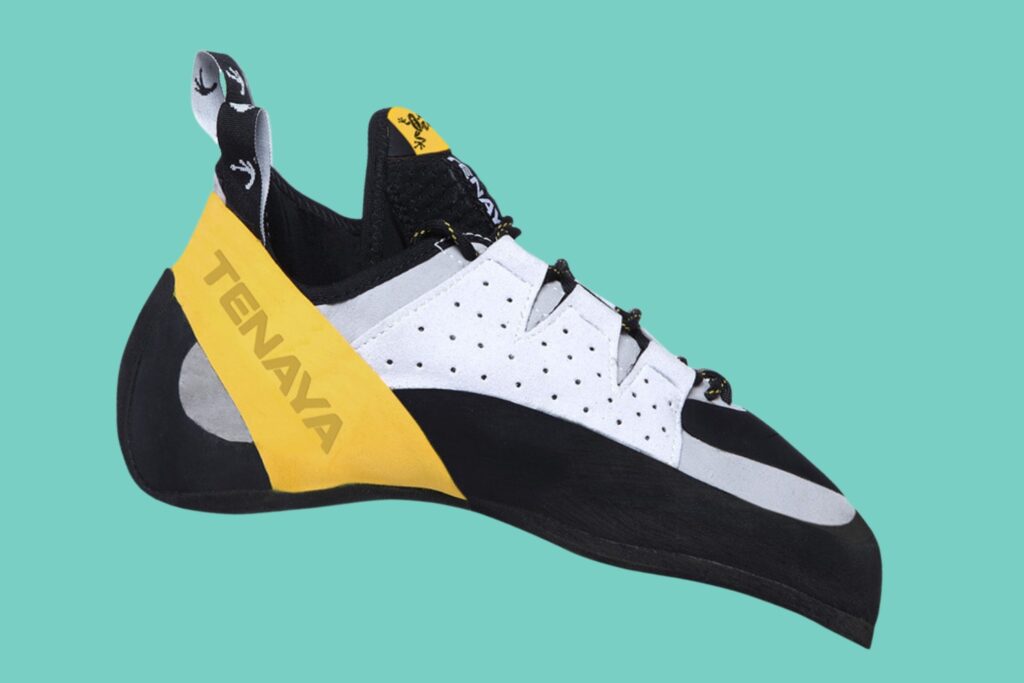
Important Specs
Weight: 5.9 oz/170 g
Upper: Perforated microfiber
Outsole: Vibram XS Grip 3.5 mm/0.1 in
Midsole: Double midsole
Vegan: Yes
Resoleable: Yes
If you aren’t familiar with Spanish shoe maker Tenaya, you may be surprised at the comfort, quality, and performance of their entire lineup. The lace-up Tarifa has superior edging power with an ultra-sensitive toe that keep your feet glued to the wall during overhanging maneuvers.
What sets the Tarifa apart from other supportive, high performance edging shoes is a more comfortable fit out of the box. Part of this is due to the shoe’s moderate downturn and overall geometry, and part is thanks to Tenaya’s clever design.
They call it “tubular construction,” and it provides a sock-like fit and feel. Tenaya adds a host of other advanced technical features that make this our number one pick for steep gym routes with delicate footwork.
Pros
Cons
4. La Sportiva Solution Comp: Best Indoor Climbing Shoe for Women
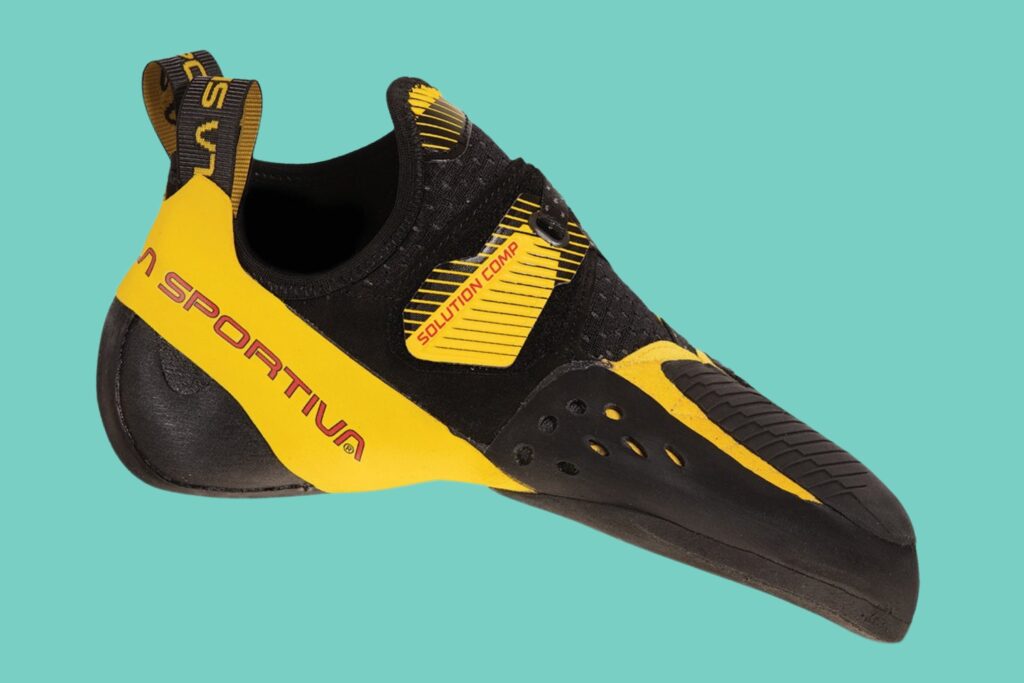
Important Specs
Performance climbing shoes
Weight: 8.9 oz/258 g
Upper: Leather and microfiber
Outsole: 4 mm/0.1 in Vibram XS Grip2
Midsole: 0.9 mm/0.03 in Laspoflex (toe only)
Vegan: No
Resoleable: Yes
Softer and more sensitive than the standard Solution model, the Solution Comp is incredibly precise in both the toe and heel. With a fairly narrow, low-volume fit, it’s not for everyone, but if it matches your foot you may have found your Cinderella shoe.
When climbing roofs, caves, 45-degree walls, and overhanging training boards, the best bouldering shoe must be flexible enough to confidently heel and toe hook, with enough downturn to allow you to grasp smaller edges with the bottom of your toes.
La Sportiva made the shoe softer with a minimal midsole that only supports the toebox. And the Solution Comp’s redesigned heel is a huge improvement over the original Solution’s molded heel cup for heel hooks.
Pros
Cons
5. La Sportiva Skwama Women’s: Best Indoor Bouldering Shoes
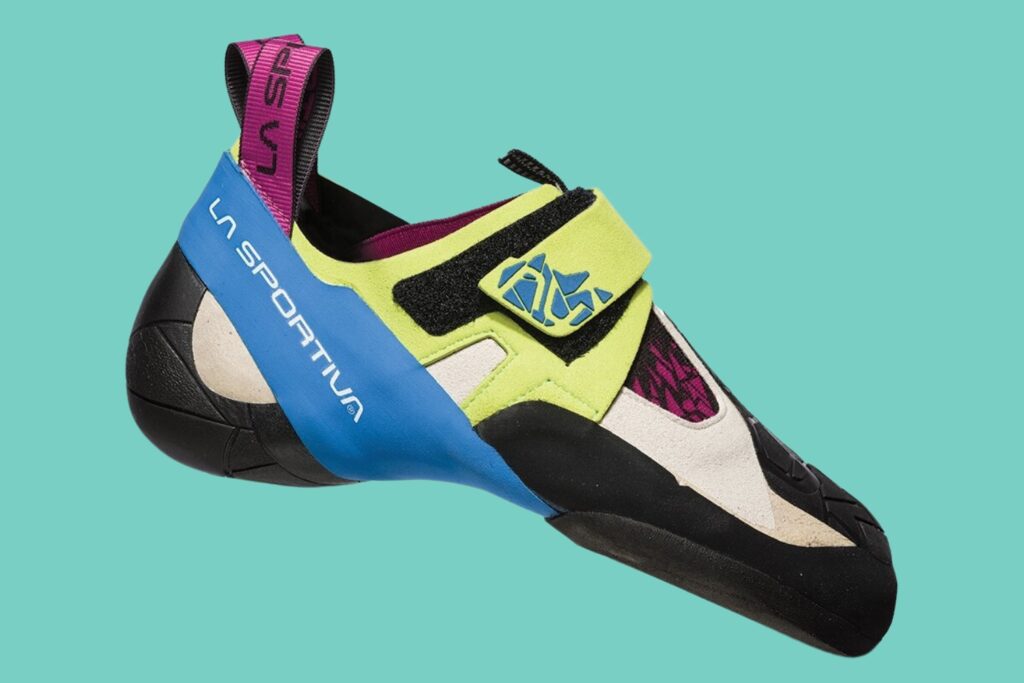
Important Specs
Weight: 7.4 oz/210 g
Upper: Leather and microfiber
Outsole: 4 mm/0.1 in Vibram XS Grip2
Midsole: 0.8mm/0.03 in Laspoflex
Vegan: No
Resoleable: Yes
The Skwama is a high-performing all-arounder that gets consistently high marks for comfort. This is partly due to its moderately downturned and asymmetrical design and partly thanks to a relatively high volume last.
The women’s version of the Skwama is built on a narrower last that fits slim heels better than the men’s version. Along with the generous toe patch, this makes the shoe good at typical climbing gym maneuvers in the bouldering cave.
The biggest complaint about the Skwama women’s shoe is that it needs a little more support on long routes with sustained small footholds.
Pros
Cons
6. Evolv Venga: Best Indoor Climbing Shoe for Kids
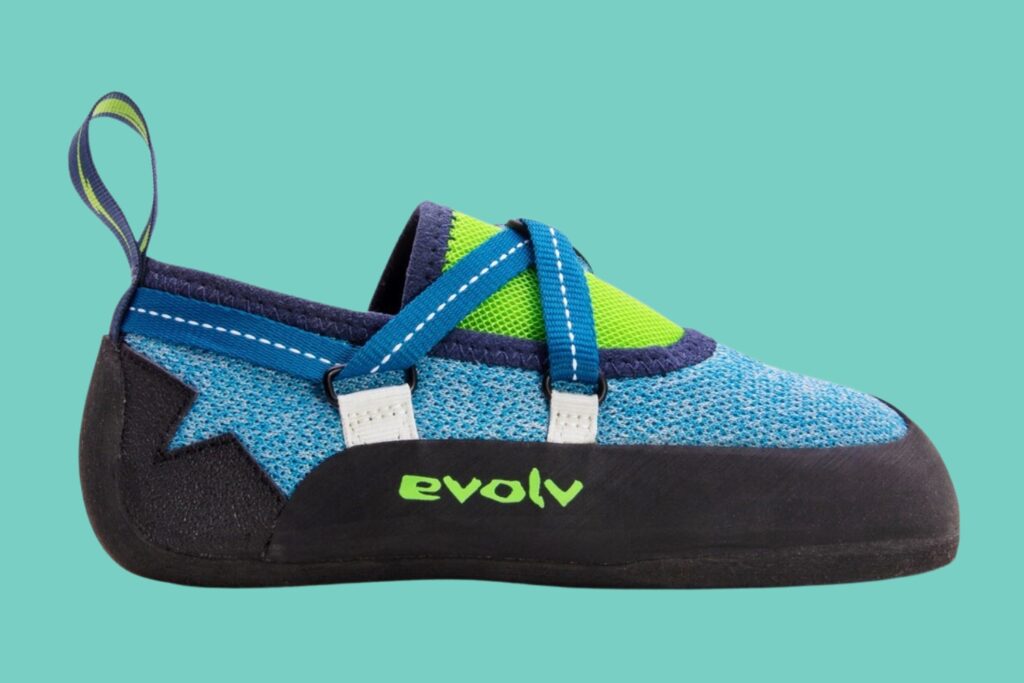
Important Specs
Weight: Not available
Upper: Synthetic mesh
Outsole: 4.2 mm/0.2 in TRAX SAS
Midsole: 0.6 mm/0.02 in full-length
Vegan: Yes
Resoleable: Yes
Most kids don’t put a lot of thought into their shoe design. They simply want shoes that fit so they can monkey around without pain. Evolv’s Venga gives young climbers plenty of performance at a value price.
The Vengas are beginner shoes built on a flat last with an accommodating shape for a wide variety of feet. The highly adaptable velcro strap closure and D-ring system also adjusts up and down to fit at least a couple sizes without buying a new pair.
While this beginner-style shoe isn’t highly adept on steep walls, it’s supportive enough to stick on fairly small holds and give kids confidence in their footwork. Sizing runs small so you may want to size up one to two sizes.
Pros
Cons
7. Scarpa Drago LV: Best Shoe for Competition Climbing

Important Specs
Weight: 7.1 oz/200 g (sz. 40)
Upper: Microsuede and leather
Outsole: 3.5 mm/0.1 in Vibram XS Grip2
Midsole: 1.0 mm/0.04 in Flexan (partial)
Vegan: No
Resoleable: Yes
A highly downturned and asymmetrical shoe based on the popular Drago, the Drago LV (for low-volume) is an even more precise tool for the most demanding indoor climbing techniques.
The Drago LV is a slipper style shoe with a partial midsole that offers just enough support for thin edges and steep sport routes. It focuses power on your big toe like a scalpel so you can feel and stand on the smallest of features.
At the same time, the 1/3 length outsole and super sticky XS Grip2 rubber keep the shoe flexible and grippy enough to contort onto volumes and smears at any angle. The M50 rubber on the toe patch and tight heel make for excellent hooking as well.
Pros
Cons
How to Find the Perfect Gym Climbing Shoe
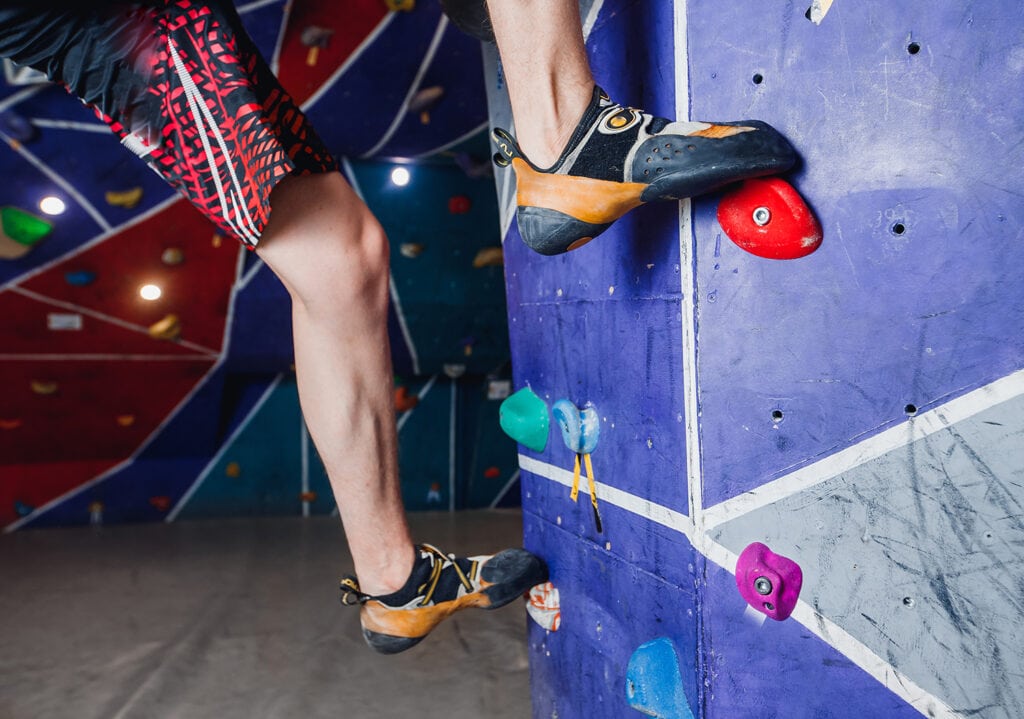
Differences Between Indoor and Outdoor Climbing
One of the biggest differences between indoor and outdoor climbing is that gyms don’t offer much crack climbing terrain. Gym climbing mainly involves sport climbing, top-roping, and bouldering on near-vertical to wildly overhanging walls.
So, indoor shoes don’t need to be as sturdily built, since you won’t be jamming your foot into rough cracks that abrade the uppers and rands. The holds indoors are also smooth and rounded compared to the sometimes razor sharp holds you’ll find on real stone. That means softer, thinner rubber can be used on the sole, which is good if you’re seeking greater sensitivity.
Important Shoe Criteria
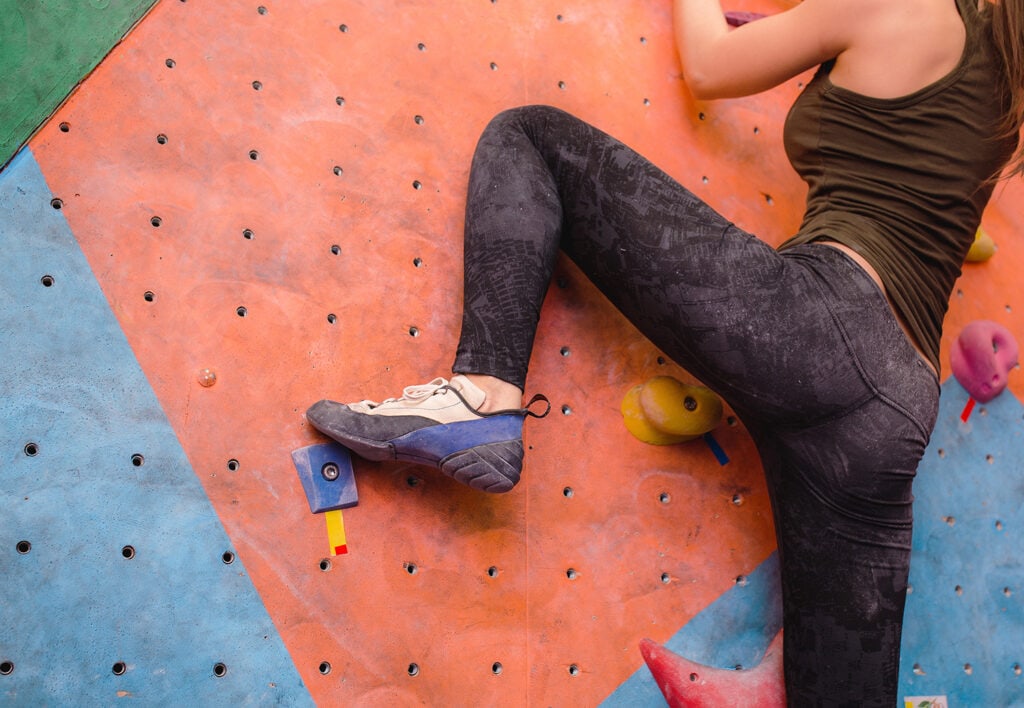
There are several qualities that you need to pay attention to when it comes to matching a shoe to your desired style of climbing.
The first one is aggressiveness, in terms of both downturn and asymmetry (inward curve). Generally speaking, more aggressive shoes will help climbers focus a lot of pressure on a small point on the toe. This allows you to stand on micro edges and jibs with confidence, where a flatter shoe might simply slip off. The downsides to this kind of performance usually comes in reduced comfort and less capability on slabs that require a lot of smearing.
The next major factor in shoe design is stiffness and flexibility. Shoes with stiffer soles offer better support on long vertical to near-vertical routes, allowing you to stand on tiny edges with much less strain. Softer shoes, on the other hand, tend to be better on overhangs and moves like hooking, smearing, and grabbing holds with your toes.
Tips for Choosing an Gym Climbing Shoes
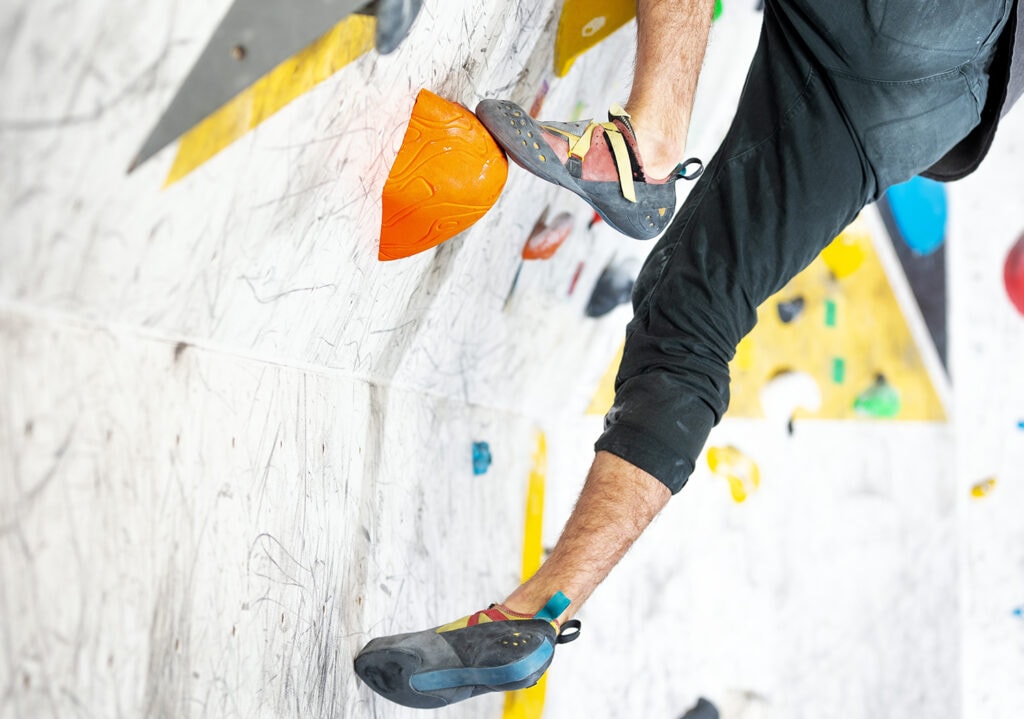
For a beginner to intermediate climber, the most important criteria for a gym climbing shoe is a certain level of comfort. You won’t be motivated to climb if you feel pain every time you pull on your shoes or step on a foothold.
On the other hand, it’s frustrating when you’re trying to get better and move up the difficulty ratings and your shoes are holding you back. If your shoes are too flat, or soft, or insensitive to reliably stick on your latest project, you might need an upgrade.
The bottom line is, you’re going to be happiest when you realistically match your shoes to your abilities and goals. The perfect gym climbing shoe is one that helps you reach your potential and succeed on the type of routes and problems you enjoy the most.
Indoor Climbing Shoe FAQs

Shoes are generally required at indoor climbing gyms. Policies may vary, but most facilities will allow you to wear athletic shoes with rubber soles or specialized shoes for climbing.
The best indoor shoes for bouldering will vary depending on the type of terrain you like to climb. Softer, more downturned shoes are better for caves and steep roofs, while stiffer and flatter shoes are preferred for their support and smearing ability on slabs and vertical terrain.
Although shoes designed for indoor use tend to be softer and more sensitive, you can still climb effectively in those shoes outside. Just be aware that they may wear more quickly in harsher outdoors conditions.
Most beginner climbers will enjoy climbing more with special climbing shoes, whether they decide to buy or rent shoes when starting. Climbing shoes give you a precise fit and added grip that helps your feet stick to small footholds and sloping surfaces. If you’re planning to mostly train indoors, then a dedicated pair of gym climbing shoes might be best.
Most gyms will allow you to wear athletic shoes or running shoes, but it’s not ideal for reasons mentioned above. You’ll have more success and more fun with shoes made for climbing!
Indoor rock climbers wear comfortable clothing that allows for full body movement, like shorts, tights, or yoga pants.
When bouldering indoors, wear loose clothing, or garments that stretch, so your movements aren’t restricted. Modern boulder problems can require gymnastic moves and a high degree of flexibility, so you don’t want clothes that bind or limit your mobility.
